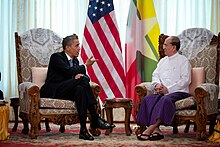Thein Sein
The developments that followed included Myanmar's appointment to chair ASEAN in 2014, improved relations with the United States, the release of Aung San Suu Kyi – his 2015 general election rival – from house arrest, and the reinstatement of major opposition party National League for Democracy (NLD) in the by-election held on 1 April 2012.[2] Thein Sein was born in Kyonku, a small Irrawaddy delta village near Hainggyi Island in what is now Ngapudaw Township to Maung Phyo (father) and Khin Nyunt (mother) in 1944 during the Japanese occupation.His parents were landless farmers, and his father made a living carrying cargo at the river jetty and weaving bamboo mats.[7] Thein Sein was appointed in April 2007 by the nation's ruling military junta[9] as interim prime minister, replacing General Soe Win, who was undergoing medical treatment for leukaemia.[15] On his first official visit outside Myanmar as prime minister, Thein Sein carried out high-level negotiations with Laos, Vietnam and Cambodia.[16][17][18] In the aftermath of Cyclone Nargis in May 2008, he led the National Disaster Preparedness Central Committee as chairman and was criticised for the government's systematic blocking of relief efforts.Thein Sein ran against National Unity Party candidate Kyaw Aye during the election, contesting a Pyithu Hluttaw seat to represent the constituents of Naypyidaw Union Territory's Zabuthiri Township.Some have considered Thein Sein as a moderate because he was willing to engage with Aung San Suu Kyi; he had a high-profile meeting with her in Naypyidaw on 19 August 2011.[40] Thein Sein appeared again during an interview in April 2023, stating that the former military regime isolated the country for 20 years and that he personally negotiated for an end to sanctions during his presidency.


Burmese namegiven nameHis ExcellencyAgga Maha Thray SithuAgga Maha Thiri ThudhammaPresident of MyanmarVice PresidentTin Aung Myint OoSai Mauk KhamNyan TunThan ShweState Peace and Development CouncilHtin KyawPrime Minister of MyanmarSoe WinMin Aung HlaingZabuthiriSanda MinKyounkuMyanmarUnion Solidarity and Development PartyKhin Khin WinAlma materDefence Services AcademyMyanmar ArmyGeneralBurmese scriptBurmeseprime ministerpolitical reformscensored mediacontroversial large Chinese-led hydro-power projectrelations with the United StatesAung San Suu Kyi2015 general electionhouse arrestNational League for Democracyby-electionKyonkuIrrawaddy deltaHainggyi IslandNgapudaw TownshipJapanese occupationBuddhist monkBachelor of Arts degreesecond lieutenantbureaucratSagaing DivisionKalay TownshipShan StateYangoncolonelGeneral Staff Officerbrigadier generalYangon DivisionHmawbiKyaingtonglieutenant generalKhin NyuntAbhisit VejjajivaNaypyidawleukaemiaNational ConventionBangladeshCambodiaVietnamCyclone Nargis2010 Myanmar general electionmilitary2010 general electionPyidaungsu HluttawNational Unity PartyPyithu HluttawNaypyidaw Union TerritoryZabuthiri TownshipPresidential Electoral CollegeSurin PitsuwanASEAN SummitWunna Maung LwinThe New Light of MyanmarBurmese economyHillary ClintonNaypyitawRohingyaUnited Nations2012 Rakhine State riotsBarack ObamaRangoonCabinet of BurmaKyaw HsanMinister for InformationAung MinTin Naing TheinSoe TheinConstitution of MyanmarShwe MannAshin NandamalabhivamsaPyin Oo Lwin2021 Myanmar coup d'étatheart diseasepacemakerWayback MachineThe IrrawaddyHassanal BolkiahNajib RazakHeads of state of MyanmarUnion of BurmaSao Shwe ThaikWin MaungSocialist Republic of the Union of BurmaNe WinSan YuSein LwinAye KoMaung MaungUnion of Burma / MyanmarSaw MaungRepublic of the Union of MyanmarMyint SweWin MyintPrime ministers of MyanmarBa SweSein WinMaung Maung KhaTun Tin